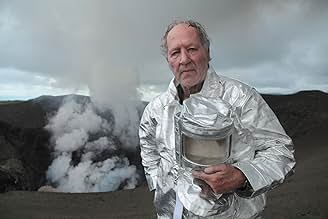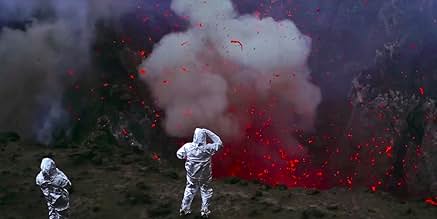An exploration of active volcanoes around the world.An exploration of active volcanoes around the world.An exploration of active volcanoes around the world.
- Awards
- 5 nominations total
Katia Krafft
- Self - Volcanologist
- (archive footage)
Maurice Krafft
- Self - Volcanologist
- (archive footage)
William McIntosh
- Self - Volcanologist
- (archive footage)
- Director
- Writer
- All cast & crew
- Production, box office & more at IMDbPro
Featured reviews
I enjoyed the volcano parts. The right turns into cultural ideologies made no sense. Pick a topic already.
A very beautiful documentary. Visually pleasing. The music is soothing and scary at times. Overall very entertaining as well.
A British-Austrian documentary; Filmmaker Werner Herzog observes some of the most beautiful and terrifying wonders of the natural world - the volcano - with his signature blend of curiosity and insight. He travels round the world, to Indonesia, Ethiopia, Iceland and North Korea to explore the effect volcanos have on their population and culture and myths. The film is significant for showing a fresh insight into life in North Korea, and a fascinating insight into the fossil hunting of early humankind in the shadow of the volcano. The primordial aspect of molten lava flow and lava explosions captured on film are extraordinary and at times unsettling, such was the danger to the cameramen and the vertigo from enormous backdrops of crimson fury.
The film meanders from one location to another and unconventional in its narrative and narration. Herzog's storytelling style is not easily pinned down, though he never loses sight of one constant here: human awe for the primeval and the elemental.
I skipped the boring parts! Which are all the parts that has nothing to do with volcanoes and eruptions so it becomes interesting and great show to me :)
The only part which is not about volcanoes and was really interesting is the one about North Korea and a little of the John From faith :) 👌🏻
The only part which is not about volcanoes and was really interesting is the one about North Korea and a little of the John From faith :) 👌🏻
Werner Herzog is a captivating man who has grand pursuits and a varied set of interests. He has made many films since his breakout hit, "Aguirre, the Wrath of God," in 1972, and all of them have either been exceptionally interesting, complex, fantastical, or illuminating in nature. Herzog makes both fiction and non-fiction films that deal with issues as diverse as colonialism, the savageness of the wilderness, ecological disasters, opera, and ski flying. With his newest film for Netflix, Herzog once again shows us that fascination is an oft neglected but empowering feeling that can be applied to numerous aspects of life. He starts us off with the topic of volcanoes, but he becomes much more fascinated with humankind at large, evidenced by his own reticence to even get close to a volcano.
Herzog reels us in with the help of Clive Oppenheimer, a Cambridge University volcanologist that he had previously worked with in the documentary, "Encounters at the End of the World," which was a film about Antarctica. Oppenheimer is a playfully compelling, if timid, guide into the world of volcanoes. He and Herzog travel the world and study volcanoes in Indonesia, Iceland, North Korea, and Ethiopia. At each of these junctures, the cultural importance of the volcano is made the fixture of the film, rather than focusing on hard science. The peoples of these regions all seem to be in awe of volcanoes, and either have a deep fear or respect for what it's capable of. In Ethiopia, a nearby volcano is the key to finding fossils of Paleolithic hominids, the rarest of human fossils. In North Korea the region's fierce patriotism is linked with its local volcano where the leaders Kim Il-sung and Kim Jong-Il once stood, proudly displaying to their nation that they were strong and resilient in the face of outside vitriol.
Though some of these excursions seem to undercut the fact that this is a film about volcanoes, this film never bores its audience. Between the panoramic shots of tropical foliage and the drone sequences that pan across villages and volcanoes alike, this is a feast for the eyes. There's a great contrast between the beauty of these regions and the oft-confusing shots of the magma that these ruptures expound with horrifying regularity. The inner regions of volcanoes look both like fire and water, and the magma often looks pitifully tame when it moves slowly down a mountainside, though it is actually a most dangerous force that will destroy all in its path. Herzog talks a bit about a couple who were volcanic photographers and were eventually killed by a fast moving cloud of volcanic ash (at 100 mph). While this tidbit is unprompted, it proves to be yet another interesting facet of these quaking mountaintops. Herzog finds many ways to look at these geographic forces, which can be seen as either benevolent or destructive in power.
Herzog reels us in with the help of Clive Oppenheimer, a Cambridge University volcanologist that he had previously worked with in the documentary, "Encounters at the End of the World," which was a film about Antarctica. Oppenheimer is a playfully compelling, if timid, guide into the world of volcanoes. He and Herzog travel the world and study volcanoes in Indonesia, Iceland, North Korea, and Ethiopia. At each of these junctures, the cultural importance of the volcano is made the fixture of the film, rather than focusing on hard science. The peoples of these regions all seem to be in awe of volcanoes, and either have a deep fear or respect for what it's capable of. In Ethiopia, a nearby volcano is the key to finding fossils of Paleolithic hominids, the rarest of human fossils. In North Korea the region's fierce patriotism is linked with its local volcano where the leaders Kim Il-sung and Kim Jong-Il once stood, proudly displaying to their nation that they were strong and resilient in the face of outside vitriol.
Though some of these excursions seem to undercut the fact that this is a film about volcanoes, this film never bores its audience. Between the panoramic shots of tropical foliage and the drone sequences that pan across villages and volcanoes alike, this is a feast for the eyes. There's a great contrast between the beauty of these regions and the oft-confusing shots of the magma that these ruptures expound with horrifying regularity. The inner regions of volcanoes look both like fire and water, and the magma often looks pitifully tame when it moves slowly down a mountainside, though it is actually a most dangerous force that will destroy all in its path. Herzog talks a bit about a couple who were volcanic photographers and were eventually killed by a fast moving cloud of volcanic ash (at 100 mph). While this tidbit is unprompted, it proves to be yet another interesting facet of these quaking mountaintops. Herzog finds many ways to look at these geographic forces, which can be seen as either benevolent or destructive in power.
Did you know
- TriviaWas one of the very few movies that was filmed in North Korea.
- Quotes
Werner Herzog: It is a fire that wants to burst forth and it could not care less about what we are doing up here
- ConnectionsFeatures La Soufrière (1977)
- SoundtracksUnfailing Light
Performed by the Monks Choir of Kiev Pechersk Monastery
Traditional
Courtesy of Origen Music
- How long is Into the Inferno?Powered by Alexa
Details
Box office
- Gross worldwide
- $3,679
- Runtime
- 1 hour, 44 minutes
- Color
- Aspect ratio
- 1.85 : 1
Contribute to this page
Suggest an edit or add missing content


















